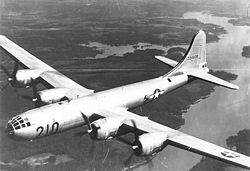Plot
In 1943, Capt. Harold "Cal" Calvert (Wendell Corey) is sent on a course at Smoky Hill, Kansas, to learn to fly a new bomber, the Boeing B-29 Superfortress. His instructor is his cousin, Major Tom West (Forrest Tucker), an officer who the other pilots think has shirked his duties by claiming engine trouble on the raid over the Ploesti oil fields. Cal stands up for Tom when a crewman taunts his cousin in front of Helen (Vera Ralston), a nurse that Tom has been seeing.
Cal and the other students learn that the pressurized B-29 can fly higher, faster and farther than any other bomber. On a test flight, when an overconfident Cal pushes a B-29 higher than instructed, a sudden decompression nearly ends in tragedy. One of the crew is sucked out of the aircraft, but is able to use his parachute. Tom is furious and reprimands Cal for endangering the test program, which the Air Force brass is monitoring closely.
Maj. Gen. Wolfe (Walter Brennan) finally declares that the pilots and the B-29s are ready for combat. He leads them to bases in China where they will launch attacks on Japan. Cal's first missions are harrowing, although the B-29s prove to be extremely effective. When the group is transferred to Guam, Tom is reunited with Helen, who is also assigned there. Cal is flying continually on high altitude missions, but Gen. Curtis E. LeMay (William Witney), the new commanding officer, changes tactics to more accurate low altitude raids that will produce more damage.
Helen is slowly falling for the more heroic Cal, and when he and Tom are on a mission together in a mass raid on Tokyo, their B-29 is hit by anti-aircraft fire. With Cal wounded and Tom at the controls, the stricken aircraft barely makes it back to the base. Tom goes back into the fiery wreckage to save a trapped crewman, but is killed when the aircraft explodes. Several weeks later, as the war ends when B-29s drop the most devastating weapon of all, the atom bomb, on cities in Japan, Cal and Helen remain together.
Reception
The Wild Blue Yonder was well received by the public, but fared poorly with critics. At best, reviewer Alun Evans considered it a "tame tribute to the B-29 bomber ... routine heroics against the Japanese ..." [5] Bosley Crowther of The New York Times wrote, "... this soggy saga of bomber airmen in World War II plows monotonously through every cliché of aerial war films before it hits the mud and then it bogs down in the bathos of mawkish heroics and tears." [6]
On September 24, 1951, on a special Lux Radio Theatre broadcast honoring the 50th anniversary of motion pictures, the lead actors, Corey, Ralston and Tucker, recreated brief scenes from The Wild Blue Yonder. [7] [Note 2]
This page is based on this
Wikipedia article Text is available under the
CC BY-SA 4.0 license; additional terms may apply.
Images, videos and audio are available under their respective licenses.

